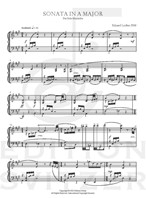
Sonata No. 1 in A-Major
Composer: Edzard Locher
Instrument: Marimba
Level: Advanced
Published: 2022
Price: €25.00
Item details
-
Description +
-
Preface
This marimba sonata is written in a „double-function form“ as in the words of musicologist William Newman (1912-2000) and stands as a conceptual sibling to Franz Liszts (1811-1886) piano sonata in b-minor. It’s to be read as a single movement in sonata form and as four movements in classic order at the same time. A third form layer occurs when looking at the two sisterworks, sonatas in F-major and c-minor. All three have the same formal structure, are thematically connected via a recurring „sister motif“ and feature three quotes from works by Danish composer Carl Nielsen (1865-1931).
-
-
Instrumentation +
-
Marimba (5-octave)
-
-
About the composer +
-
Edzard Locher (born 1989 in Tettnang, Lake Constance) studied percussion, composition and pedagogy in Zurich. He was percussionist with Kiel Philharmonic and Hof Symphony and is principal percussionist with Hessen State Orchestra Wiesbaden since 2016 as well as an associate professor at Wiesbaden Music Academy. He composes works for percussion and has specialized in percussion arrangements of classical music.
-
-
Reviews +
-
Percussive Notes, February 2023
Edzard Locher describes his “Sonata in A Major” as being written in a “double-function form.” He states, “It’s to be read as a single movement in sonata form and as four movements in classic order at the same time. A third form layer occurs when looking at the two sisterworks, sonatas in F-major and E-minor. All three have the same formal structure and are thematically connected via a recurring ‘sister motif.’” This sonata is beautiful in its musical output and simultaneously daunting in its technical and musical difficulty.
Locher includes very specific notation for rolls, described at the beginning of the score, including mandolin rolls, one-hand rolls, and a specific hand with which to start or end the roll. This takes some artistic freedom away from the performer but allows a performance that is accurate to the composer’s intentions. These specific aspects of notation, rapidly changing time signatures, complex rhythms, and other challenges combine to present a large, but exciting, challenge to any performer.
I recommend this piece for an advanced university or professional marimbist. There are significant technical and musical challenges, but the result is a beautiful, large-scale work for solo marimba.
—Justin Bunting
-
-
Credits +
-
With support from Koda’s Cultural Funds
Painting: "La Primevère" by Alfons Mucha (1860-1939)
Front Cover Design: Nicola Lee
Photo: Christoph Risch
Printed in Copenhagen, Denmark
Copyright © Edition SVITZER
www.editionsvitzer.com
-




